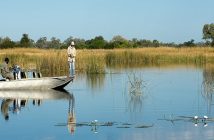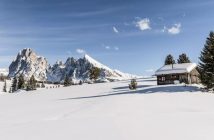Kenya’s Samburu reserve is the only place in East Africa where you can track critically endangered black rhino by foot. Lizzie Pook pulls on her hiking boots and sets off into the bush…
The heat in Kenya’s Sera Conservancy is almost soporific. As I stand, watching a crash of rhinos hidden in a tangle of thick desert rose bushes, I can feel myself being lulled by their meditative chomping. Like boulders grinding together, the sound of their cud-chewing carries on the thick, molten air, weaving around my ears like heavy smoke.
Suddenly, to my right, there’s a flurry of activity. I’m jolted from my stupor and turn to see a pack of wild dogs barrel by about 20 metres away, their collective fur a dark swirl of marble. There must be ten of them – they’re on the hunt, gunning full pelt for the tiny dik dik antelope that’s streaking away in front of them. Eventually, they disappear into a small copse, and a piercing shriek rings out, raising the hairs on my neck and stopping us dead in our tracks. It’s the dik dik, the poor chap. He’s had it.
![]()
I’m in the Sera Conservancy, in north Kenya’s wild Samburu National Park, where the rangers spend their days tracking the 11 endangered black rhinos that have been successfully re-introduced into the 860,000-acre reserve after a 30-year absence. Today, I’m joining them on foot, and after setting off at 5.30am, with Venus still burning bright in the sky, I’ve already been read the rule book. Really, the key messages are very simple: follow the sign language (‘stop’, ‘shut up’ and ‘get a move on,’ basically), stay as quiet as you possibly can and never, NEVER run – unless you want to be viewed as prey by the many animals in this reserve that could kill you.
I’m joined by Joseph, a Samburu tribesman who acts as my guide, and Jonathan, a local park ranger, clad head-to-toe in khaki. The three of us walk in single file (as silently as is possible in clunky hiking boots and, at one point for me, with a bout of hiccups), picking our way over giraffe bones, stopping to assess honey badger tracks and side-stepping steaming animal dung. Every couple of minutes Jonathan reassesses our position with his GPS tracker – a retro cacophony of whirs, blips and white noise – and Joseph shakes his rudimentary wind gauge (a sock filled with ash), which he jiggles occasionally to ensure we’re staying downwind of any really big beasts.
![]()
You’ll know when you’ve come upon a rhino as you can practically feel the presence of the animal in the air. Something shifts. There is a change in the atmosphere. So when we come to a small ravine we wait, breath collectively held, until Joseph puts his hand to his ear and raises his eyebrows. Then we hear it – the pantomime crunching of thick leaves being shredded though pestle-and-mortar teeth. In front of us, a bush sways lopsidedly and a rhinoceros emerges, feasting lustily on its leaves.
She is, it turns out, hugely pregnant, her belly swollen and distended beneath her, and we watch in silence as she meanders between bushes, her crunching audible above the squabble of guinea fowl and screech of red billed ox peckers around us. She comes within about 15 metres, never noticing we are there but occasionally pausing to twitch her ears, before ambling on to continue her repast.
Top of the rock
As we continue to stalk our way through the bush, I ponder what beady-eyed creatures might be watching from the foliage around us. My mind leaps back to the cheetah kill I witnessed just 24 hours before in nearby Samburu reserve – a methodical, calculated, swift assault by three sisters attempting to bring down a sizeable antelope.

The Samburu reserve, just an hour and half’s drive away from Sera, is bubbling with life and is a thrill for the senses; as you meander through in your open-top vehicle, you’ll hear the trill of the slate-coloured boubou bird, the deep guttural purr of elephants communicating across kilometres, and the clash of horns as gazelles fight in a billow of dust. Eyes feast on rainbow-coloured Lilac Breasted Rollers, cartoonish hornbills, burnt-amber reticulated giraffes and the flash of a leopard packed tightly into a tree.
At the exquisite Saruni Samburu Lodge, intricately carved into the cliff-face like Fraggle Rock, you can stand in your outdoor waterfall shower and watch as herders move their camels, goats and donkeys across the sprawling, scrubby plains. Or witness ostriches tearing away into the distance like a flock of speedy, stringy Ss. At night, the sky erupts into a riot of stars, like a million pin-pricks in black linen, and we set out excitedly with torches to find scorpions illuminated in the UV beams.
On our night safari we came across a trumpeting herd of elephants – parents blustering over their tiny young – and spotted genet cats, bush babies, bat-eared foxed and black backed jackals in our headlights. Each night, as I walked back to my room in the inky darkness, I kept an eye out for Ugali, the resident leopard, who has been known to potter across to people’s terraces as the sun goes down.

Back in Sera, as we make our way home to Saruni Rhino Camp – where my beautiful storm-lantern-strewn stone banda is so open to the elements I can hear hyenas hunting baby elephants and leopards fighting just metres from my bed at night – the unholy screech of an eagle owl cuts through the air. We pass trampled bushes, inevitably mown down by marauding rhino, and are screeched at by boisterous ‘go-away birds’, who aren’t at all happy with us being on their turf.
As the sun goes down, painting powder pink smears across the horizon, herds of prehistoric-looking giraffe and oryx mill quietly around us in the dying light. ‘This,’ I think, is what it really feels like to be immersed in the wild.
A week-long safari combining Saruni Rhino and Saruni Samburu costs from £7,390 per person (excluding international flights). Book with Africa Exclusive; safari.co.uk (01604628979).



